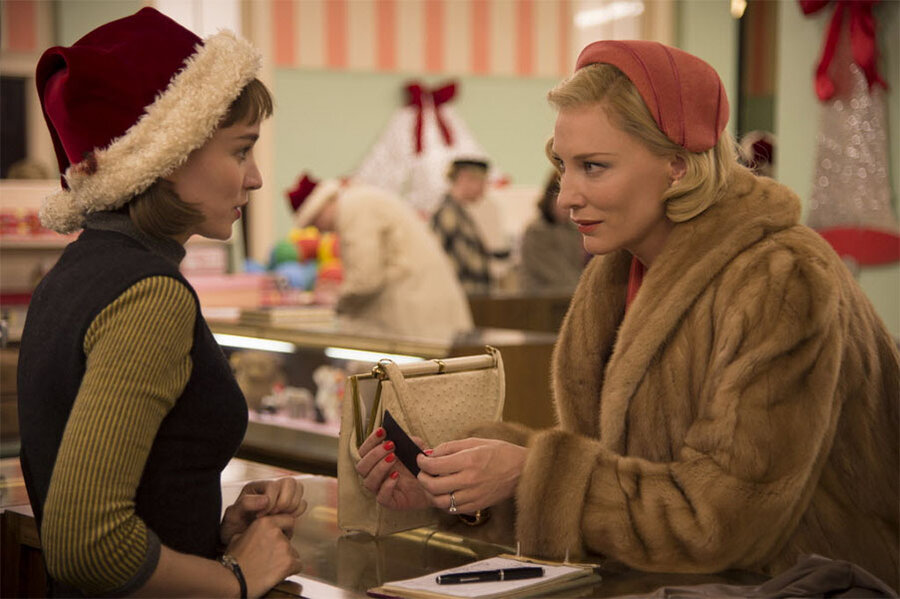'Carol' director Todd Haynes: How the director has become a master of melodrama
Loading...
Subtle and gorgeous, Todd Haynes' period romance "Carol" swells and staggers with the tremors of an unexpected love. The setting (1950s New York) and the characters (played by Cate Blanchett and Rooney Mara) may seem remote to some, but few won't recognize the film's dreamy undulations of emotion – including the director, himself.
"It so has put me back into the mind of a much younger me when I, unfortunately, filled up many journals worth of meticulous observation and analysis and recounting of residual events that would occur in the company of that person," Haynes said in a recent interview. "What's funny is what a solitary predicament you find yourself in."
That the 54-year-old, Portland, Oregon-based Haynes was, from the start, a careful chronicler of passions should come as little surprise. In his six feature films and the HBO miniseries "Mildred Pierce," Haynes has grown into a master of melodrama with a knack for lushly textured films that summon earlier eras with precision and power.
"Carol," which has already been feted at the Cannes Film Festival and been ranked among the expected Oscar contenders, is adapted from a Patricia Highsmith novel originally published as "The Price of Salt" under a pseudonym in 1952. Mara plays a young department-store clerk named Therese who's drawn into a relationship with Blanchett's Carol, an elegant, experienced woman whose marriage is crumbling.
Their romance unfolds like a crime, hidden from view amid the male-dominated midtown of '50s New York. Men often clutter the frame in "Carol" – the closed-minded or oblivious impediments of a time that shunned homosexuality.
"There are all kinds of obstructions and they're built into so many frames of the film," says Haynes. "It makes you think about looking and who's looking at whom and the frustration of not getting to what you want."
Such details, mixed with elements like Carter Burwell's sumptuous score and the camera's keen attention to slight but meaningful gestures (a glance, a hand on a shoulder), show Haynes in full command of his filmmaking.
"He primes the canvas really meticulously. You can feel the textures and the atmospheres building up and accruing during filming," says Blanchett, who also starred in his 2007 Bob Dylan drama "I'm Not There." ''He would come in and he would just smooth a hair. He's quite painterly about the way he assembles the whole thing. It feels like it's got Todd's hands all over it."
The Los Angeles-born Haynes, who studied semiotics as an undergrad at Brown University, has regularly been drawn to stories with gleaming surfaces that cloak inner turmoil. His first film, "Superstar: The Karen Carpenter Story," about the singer, was made with modified Barbie dolls. His first feature, "Poison" – a series of tales about homosexuality – was labeled pornography before its release but became a touchstone of what was called New Queer Cinema. In "Safe" he explored the life of a San Fernando Valley homemaker (Julianne Moore) and in "Velvet Goldmine" dove into 1970s glam-rock.
"Carol" marks his second '50s-set film after "Far From Heaven," the Oscar-nominated, Douglas Sirk-inspired melodrama about a Connecticut housewife (Moore, again) whose husband is gay.
"It's been one of the great evolutions in a career to see him grow as a moviemaker with every new movie," says Kent Jones, director of the New York Film Festival at Lincoln Center, which is running a retrospective of Haynes. "I thought with 'Mildred Pierce,' Todd took a huge, huge leap forward – and the same with 'Carol.' I think 'Carol' is just absolutely the most nuanced, subtle, most beautiful film he's ever made."
Christine Vachon, Haynes' longtime producer, says its Haynes' obsession for detail that distinguishes him.
"Every single thing in the frame is there for a reason, that draws you in, that augments the emotionality," says Vachon. "Whether it's the color of the couch or the music or the performance of the actor, the construction of everything you see and hear is so beautiful rendered and thought out."
At the center of virtually all of his films have been knockout performances by women, a trademark he's proud of. But he's also frustrated by Hollywood's perpetual "amnesia" that films about women are necessary and successful.
"It's always sort of like: 'Oh, wow, there's an audience out there for this! We had no idea!'" says Haynes, who'll next make Brian Selznick's "Wonderstruck" with Moore. "And yet the same revelation seems to kick in every time. It doesn't seem to produce a pattern of commitment to producing similar kinds of work."
In "Carol," Haynes wanted to capture Phillis Nagy's script through a female perspective. He drew on the photographs of Ruth Orkin and Vivienne Meyer, as well as, for period reference, the 1956 film "Lovers and Lollipops."
His penchant for period films, he says, "is a purely selfish desire to learn about different periods, to almost feel like I get to live through them."
For those who have swooned through "Carol," its '50s romance could hardly seem more alive.





